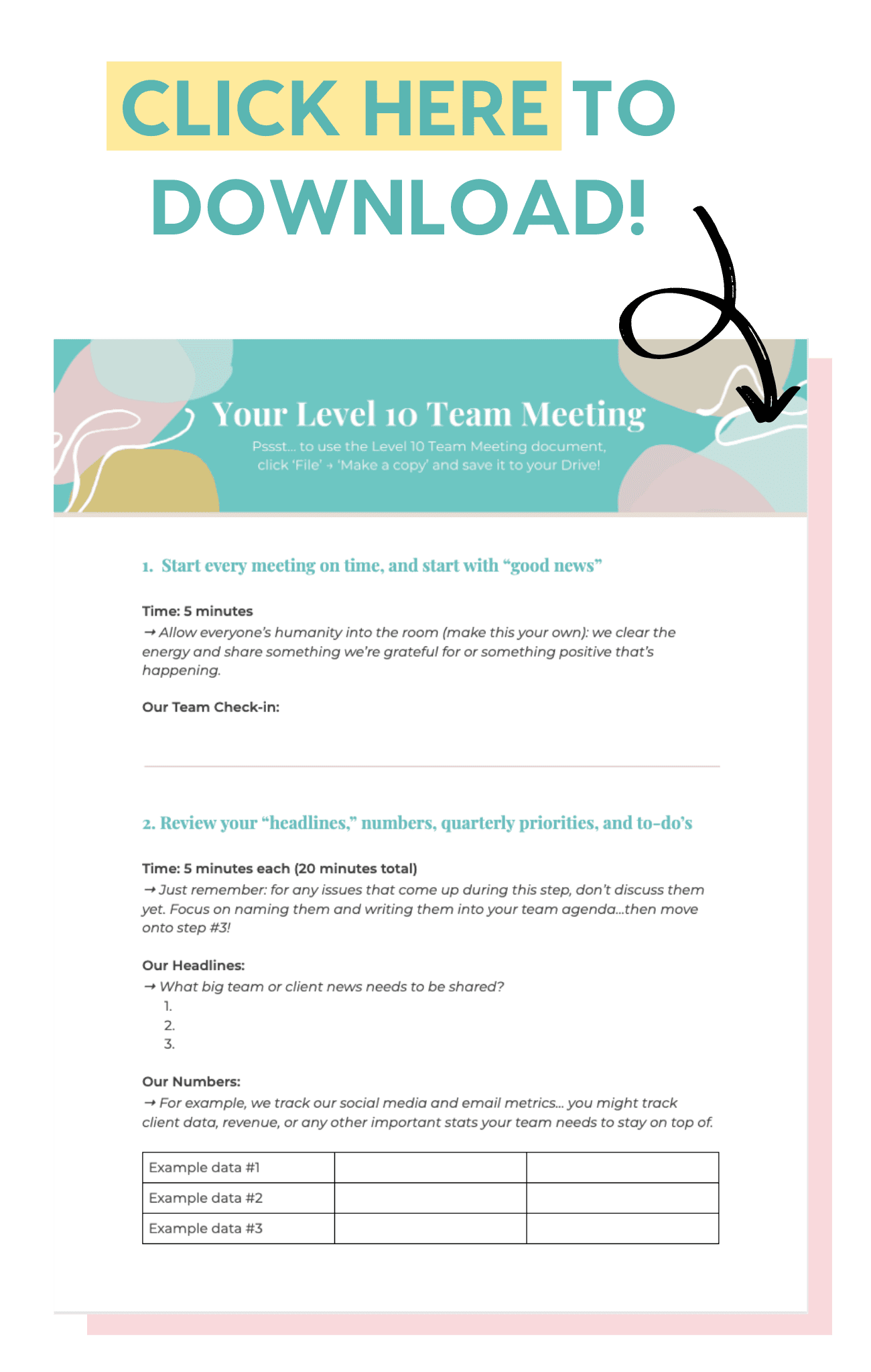Real talk: have any of these thoughts run through your head while meeting with your team?
👉 “What is the point of this meeting?!”
👉 This could’ve been summarized in an email.”
👉 “Haven’t we talked about this problem a million times before? When will we actually resolve it?”
👉 “Wait a second, wasn’t this meeting supposed to be over twenty minutes ago?!”
You’re NOT alone.
The problem isn’t the meeting itself. Often, the best way to work through issues and get everyone on the same page IS by getting everyone in the same (Zoom) room.
The real problem is how the meeting is run—the specific format you are (or aren’t) using.
Which is why here at SelfSpoken, we’ve implemented a new team meeting format called the Level 10 Meeting. (pssst… we’re even sharing a FREE downloadable guide for running your own Level 10 meetings!)
And it has revolutionized the way we meet…
✔️ we’re on top of our quarterly goals and weekly to-do’s
✔️ we use our time together to solve problems and take ownership of next steps
✔️ we’re able to anticipate problems that *may* arise and devise back-up plans
✔️ we start and end on time
✔️ and we’re even getting to know each other better in the process!
Here’s that productive meeting format we’re using: check out this video from EOS Worldwide for a breakdown of the Level 10 Meeting Agenda.
Psst… skip to 1:30 minutes in for the good stuff!
Key elements of the Level 10 Meeting, and why they work:
1. Start every meeting on time, and start with “good news”
Time: 5 minutes
We’ve tweaked this step to start with the following two questions:
- Anything you need to clear? (This is usually where team members get to share something frustrating they’re dealing with that they need to release so they can be focused for the rest of the meeting)
- What’s one win, or something you’re grateful for right now? (This can be personal or professional!)
Here’s why: it’s important to let everyone’s humanity into the room. Of course, you want to preserve boundaries and not devolve into oversharing or personal drama…
But the people we work with are PEOPLE, and often we don’t take into account the energy we’re bringing into the room based on where we just were—physically or emotionally—before the meeting.
2. Review your “headlines,” numbers, quarterly priorities, and to-do’s
Time: 5 minutes each (20 minutes total)
Going over these items is important for a few reasons:
- It spreads responsibility and ownership amongst your team. Each person is responsible for reporting on the progress of projects they’re “in charge of,” which makes them even more motivated to make that progress they’ll be reporting on.
- It holds everyone accountable to following through on the tasks they committed to in previous meetings. Plus, there’s a lot of catharsis in seeing the to-do list shrink throughout the quarter.
- Everyone gets a much fuller picture of what’s going on within the team—it’s freeing to know that you don’t have to keep tabs on stuff that doesn’t fall under your umbrella of responsibility, but you still get updated on everything.
Just remember: for any issues that come up during this step, don’t discuss them yet. Focus on naming them and writing them into your team agenda… then move onto step #3!
3. Identify, discuss, and SOLVE issues that came up during step #2
Time: 60 minutes
Once you’ve talked through the four elements of step #2, you’ll have everyone on the same page… and most likely, you’ll have come up with a list of issues, sticky points, and topics that need to be discussed as a team.
By waiting until everyone has reported their top info from step #2 before digging into identifying, discussing, and solving the problems that come up, you:
- ensure that the highest priority issues get handled first and foremost.
- prevent unnecessary back-and-forth both during AND after the meeting, because the problem-solving and teamwork happens in real time, all at once.
Even if you don’t solve every problem on your list during the 60 minutes allotted to this section, you’ll have had plenty of time to take care of your high-priority issues, and the rest can usually be handled via email or at the next meeting.
4. Wrap up the meeting and end (on time!)—with that same human connection you started with
Time: 5 minutes
After you’ve problem-solved for an hour, it’s time to move into the wrap-up stage of your Level 10 meeting. You’ll:
- recap everyone’s to-do’s for the week to make sure all team members understand what they’re responsible for getting done.
- determine if anything needs to be “cascaded” out to others who aren’t in the meeting.
- have everyone rate the meeting from 1-10 to reflect and continuously improve the quality of your meetings.
Our team has added one last step to the Level 10 meeting wrap-up… we like to end our calls with a “soul question.”
To give ya an example, when we met on MLK Day in January, we all shared what came to mind when we thought of Dr. King’s legacy and the role he plays in present-day culture.
Soul questions like this are about fostering open and honest team communication and personal connection. For us, it’s all about creating a culture of realness and belonging.
Plus, it’s such a treat to get to know my team members on a deeper level beyond their skills and professional responsibilities!
Ready to run a Level 10 Meeting of your own? Here’s a free copy of the meeting agenda we use every week!
You’ll find all the steps covered in the video from EOS Worldwide, plus the additions we’ve made here at SelfSpoken for boosted interpersonal connection and communication.

Don’t be afraid to adapt this agenda for your own team—I’ve left some areas open for you to tailor it to exactly the agenda YOU and your team need, so you can start having Level 10 meetings every single time.
Want to learn how to show up in your communications with more focus and efficacy, whether over Zoom or back in the face-to-face world?
Could your team benefit from learning these skills too? I’m talkin how to:
👉 ditch distracting habits and project credibility through a screen
👉 structure your meetings and presentations so they work for you instead of against you
👉 translate your in-person communication style to the virtual world, so you hook your audience from the beginning and keep them engaged the whole way through…
Then you’ll want to contact us to book one of SelfSpoken’s signature team trainings!
Here’s what some recent team leads have to say…

Love,


Oh Baby! Hello From The Other Side…
Some goodies to tie you over while I’m out on maternity leave Guess what? On October 14th, my husband, daughter and I took the…
Have you ever wanted to improve your communication skills and day-to-day speaking confidence, but the advice you found online or in self-help books just……
Picture this: You’ve just given your colleagues a status update about something you’re working on and then… *Crickets* – an awkward silence. You think…



